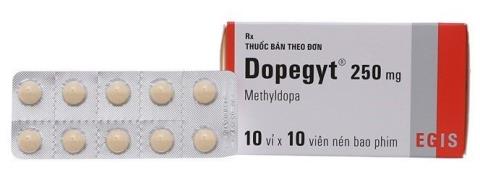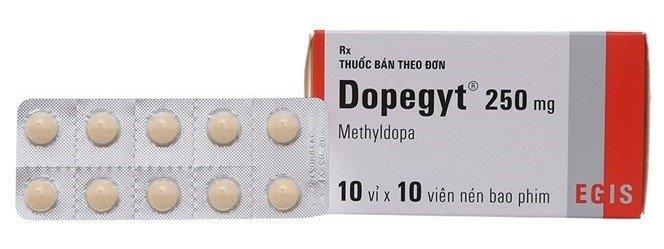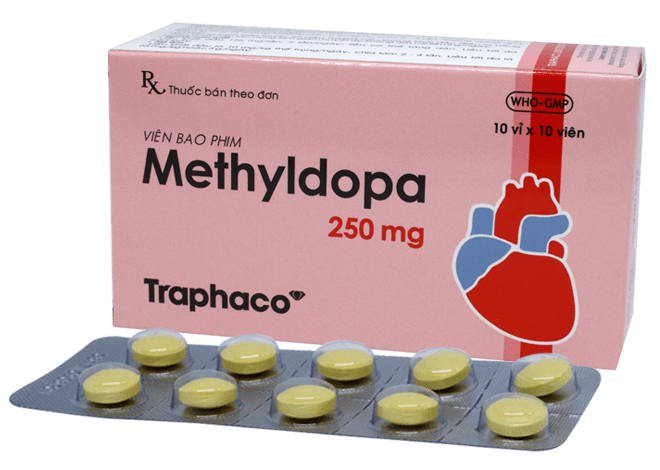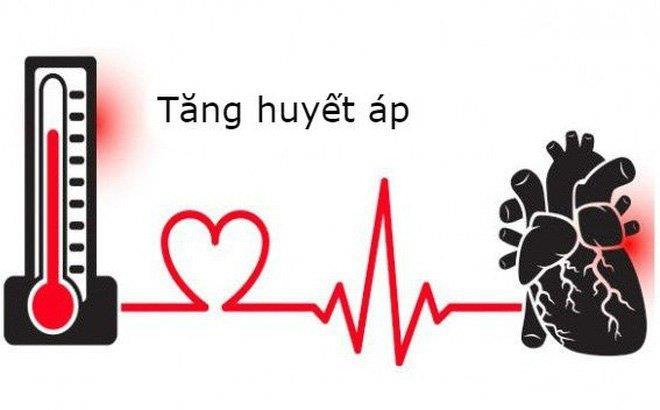Methyldopa antihypertensive drugs: uses, uses and precautions

What is Methyldopa? How is the drug indicated in pathological cases? How to use it and what to keep in mind throughout the course of taking the drug? Let's learn and analyze Methyldopa with SignsSymptomsList through the article below!
Active ingredient name: methyldopa.
Names of some brand-name drugs containing similar active ingredients: Apo-Methyldopa, Bethyltax, Dopegyt,...
content
- 1. What is Methyldopa?
- 2. Uses of Methyldopa
- 3. Cases where Methyldopa should not be used
- 4. Instructions for taking Methyldopa
- 5. Side effects of Methyldopa
- 6. Drug interactions when taking Methyldopa
- 7. Notes when taking Methyldopa
- 8. Special subjects when using Methyldopa
- 9. Dealing with an overdose of Methyldopa
- 10. What to do when you miss a dose of Methyldopa
- 11. How to store Methyldopa
1. What is Methyldopa?
Methyldopa belongs to the group of antihypertensive drugs that inhibit the central sympathomimetic (paralysis). The drug is prepared in the form of tablets with a strength of 250 mg:


2. Uses of Methyldopa
Methyldopa is indicated in some cases:
- Hypertension
- Paroxysmal hypertension (intravenous use) but rarely used now
- Hypertension in pregnancy

Keep in mind that this is a prescription drug and should only be used under the direction of a doctor.
3. Cases where Methyldopa should not be used
The drug is contraindicated in the following cases:
- Patients with hypersensitivity to any ingredient of the drug
- Active liver disease such as acute hepatitis and active cirrhosis
- Liver dysfunction associated with previous methyldopa treatment
- Acute disorder of porphyrin metabolism
- Pheochromocytoma
- People suffering from depression taking MAO inhibitors
- Hemolytic anemia
4. Instructions for taking Methyldopa
4.1. Dosage
Methyldopa is a prescription medication. Dosage should be adjusted according to the age and symptoms of each patient. The dose of the drug will vary from person to person. You should note that the doses shown below are for reference only . Therefore, you must not arbitrarily take but must strictly adhere to the dose that the doctor instructs.
Adult:
- Treatment initiation: The usual starting dose of methyldopa is 250 mg, 2 to 3 times a day, for the first 48 hours. This dose is then adjusted according to the individual patient's response. To minimize the sedative effect, the dose should be increased in the evening.
- Maintenance therapy: The usual dose of methyldopa is 0.5 - 2 g/day, divided into 2 - 4 times. The maximum recommended daily dose is 3 g.
- A thiazide diuretic should be used in combination if thiazide therapy is not initiated or if blood pressure lowering is not achieved with methyldopa 2 g/day.
Elderly:
Initial dose 125 mg, 2 times daily, dose may be increased gradually. Maximum dose 2 g/day. In the elderly, syncope may occur with use possibly due to increased sensitivity to the drug or to advanced atherosclerosis. This can be avoided by taking a lower dose.
Children:
The starting dose is 10 mg/kg body weight/day, divided into 2-4 times. The maximum dose is 65 mg/kg or 2 g/m 2, or 3 g/day, whichever is the smallest.
4.2. How to use
The drug is used orally. You can take the medicine before or after eating.
5. Side effects of Methyldopa
Unwanted effects you may experience when using:
- Body as a whole: Headache, dizziness, fever
- Circulatory: Postural hypotension, orthostatic hypotension, edema
- Central Nervous System: Sedation
- Endocrine: Reduced sex drive
- Gastrointestinal: Dry mouth, nausea, vomiting, diarrhea
- Respiratory: stuffy nose
You should inform your doctor about any unwanted effects you experience while using the drug.
6. Drug interactions when taking Methyldopa
You should not use concurrently with:
- Diuretics and other antihypertensive agents: may enhance antihypertensive effect, increase adverse drug reactions.
- Anesthesia: must reduce the dose of anesthetic; If blood pressure is lowered during anesthesia, vasopressors can be used
- Lithium: increases the toxicity of lithium
- Monoamine oxidase (MAO) inhibitors: because they cause excessive lowering of blood pressure
- Amphetamines, CNS stimulants, tricyclic antidepressants: reduce the antihypertensive effect and lose blood pressure control
- Digoxin: increases the effect of slowing the heart rate
- Levodopa: increased antihypertensive effect and increased neurotoxicity
- Iron-containing drugs: because iron reduces the absorption of methyldopa leading to a decrease in plasma concentrations of methyldopa and a decrease in the antihypertensive effect of methyldopa.
- Oral contraceptives: because they increase the risk of damage to blood vessels and make it difficult to control blood pressure
7. Notes when taking Methyldopa
A few notes when using the drug such as:
- It is advisable to periodically check the red blood cell count, hemoglobin, hematocrit and do liver tests during the first 6-12 weeks of treatment or when the patient has a fever but the cause is unknown.
- Methyldopa can cause a false-positive Coomb test. When taking drugs that detect positive Coomb's test or signs of anemia, it is necessary to check to confirm hemolysis. If hemolytic anemia is confirmed, the drug must be stopped
8. Special subjects when using Methyldopa
8.1. Pregnant and lactating women
Methyldopa can be used in people with pregnancy-induced hypertension. The drug is not teratogenic, but among infants born to mothers who were treated with the drug during pregnancy, periods of hypotension have occasionally been observed.
Methyldopa is excreted in human milk, which may pose a risk to the infant at therapeutic doses normally used by nursing mothers. Therefore, the drug should not be used by nursing mothers.
Consult your doctor before taking the medicine.
8.2. Drivers or operators of machinery
Methyldopa can cause drowsiness, so do not drive or operate machinery while taking it
9. Dealing with an overdose of Methyldopa
Acute overdose can cause hypotension with dysfunction of the brain and gastrointestinal system (excessive sedation, bradycardia, constipation, flatulence, diarrhea, nausea, vomiting).
When experiencing the signs listed above, you should stop taking the drug and immediately go to the nearest medical facility for timely treatment.
10. What to do when you miss a dose of Methyldopa
If you forget to take a dose, take it as soon as possible. However, if it is almost time for your next dose, skip the missed dose and take your next dose at the scheduled time. Do not take double the prescribed dose.
11. How to store Methyldopa
Store the medicine in a cool, dry place, at a temperature not exceeding 30oC, away from direct light.
Note: Keep out of reach of children and read instructions carefully before use.
Through this article, SignsSymptomsList has helped you answer the question of what Methyldopa is, its uses, how to use it and what to keep in mind when using it. The use of the drug requires the guidance of the treating physician. In the process of using the drug, if any unwanted effects occur, please contact your doctor immediately for advice on the best solution!
Pharmacist Nguyen Hoang Bao Duy